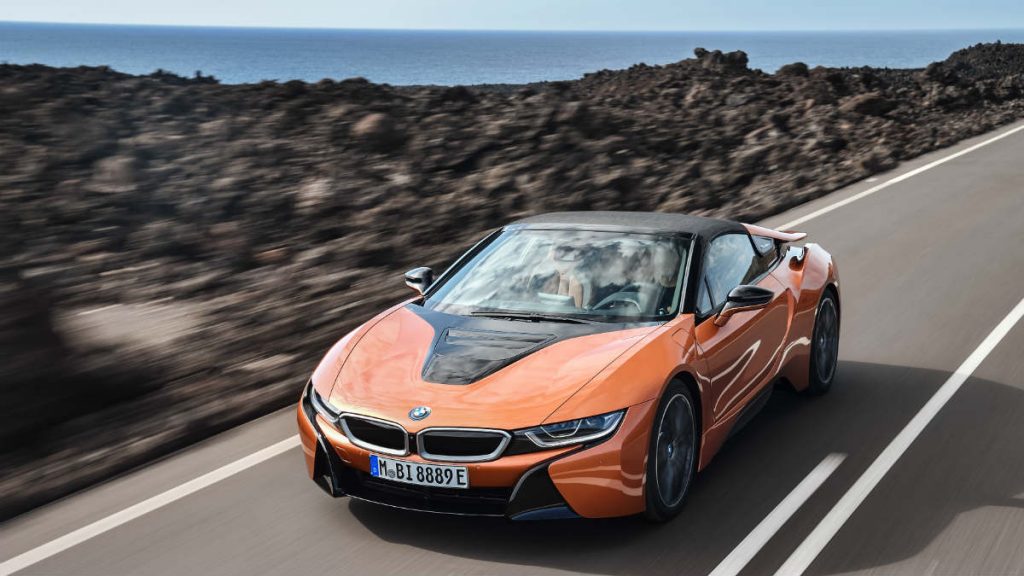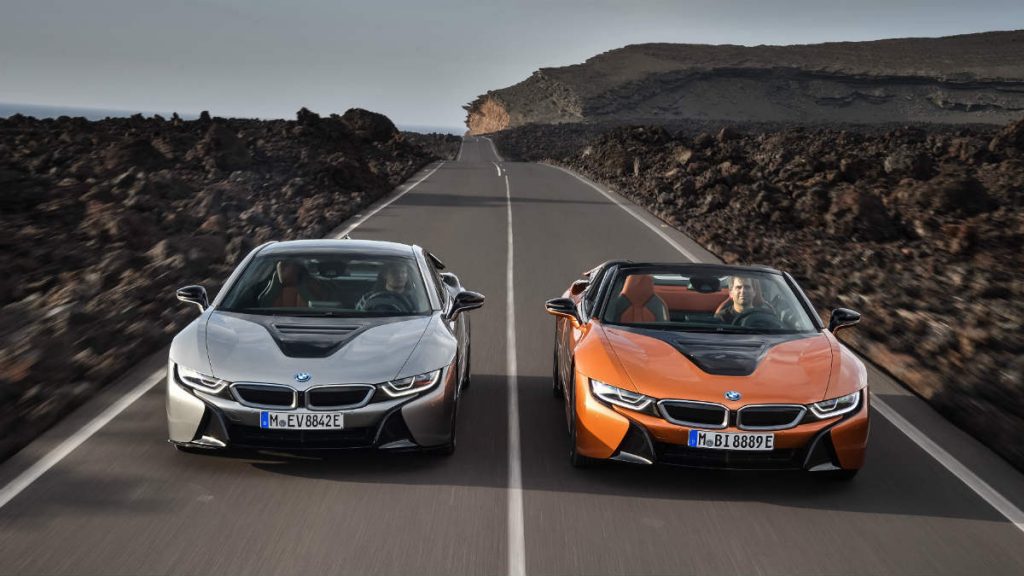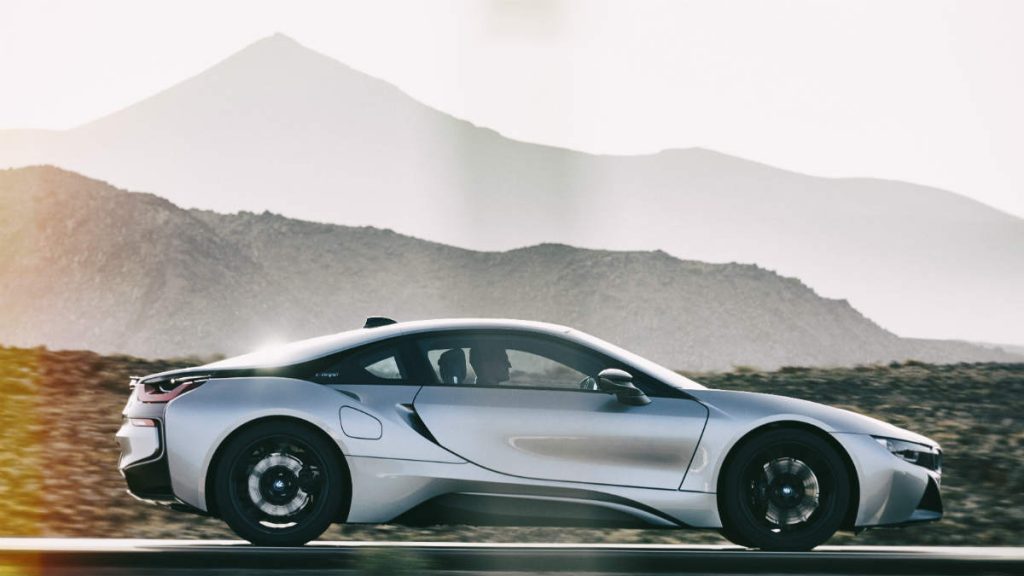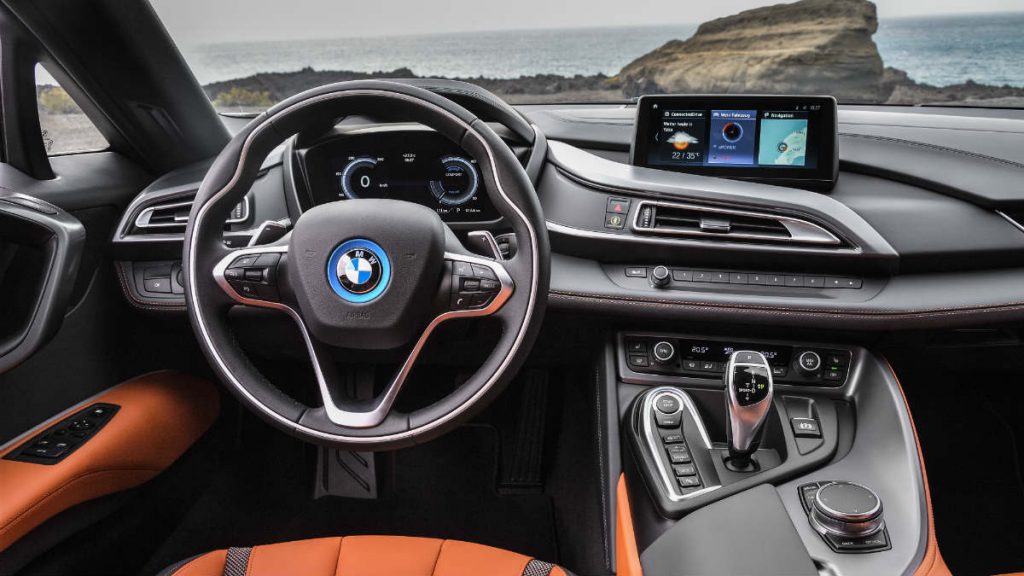The new BMW i8 Roadster and Coupe.
Another intoxicating chapter is about to be written in the success story of the BMW i8, as the updated version of the 2+2-seater – the world’s highest-selling plug-in hybrid sports car since its launch in 2014 – is joined by the new BMW i8 Roadster in the line-up. The open-top two-seater with electrically operated soft-top adds a whole new sensation of freedom to the combination of locally emission-free mobility and high-caliber performance. It opens the door to virtually silent motoring with zero CO2 emissions, bringing an extra edge of purity to the experience of open-top Sheer Driving Pleasure. Like the new BMW i8 Coupe, the new BMW i8 Roadster is based on the LifeDrive vehicle architecture with aluminum chassis and carbon-fiber-reinforced plastic (CFRP) passenger cell. The further optimized BMW eDrive technology employed in both models comprises a high-voltage battery with significantly expanded cell capacity and energy content, and an electric motor generating a higher peak output. The result is a noticeable increase in dynamic performance, operating range and the amount of driving possible using purely the electric drive system.

The proportions, lines, and surface design mark out both the BMW i8 Coupe and BMW i8 Roadster as belonging to a new breed of sports cars. On an individual level, the BMW i8 Coupe stands out as an extremely sporty 2+2 seater, while the BMW i8 Roadster oozes all the freedom of open-top motoring for two. The two models sport “Coupe” or “Roadster” lettering respectively on their C-pillars. The choice of exterior paint finishes now includes the new E-Copper metallic and Donington Grey metallic shades. The BMW i8 Roadster carries over the BMW I design language into another vehicle concept and is awash with individual highlights that radiate elegance and fire the emotions. The soft-top roof has a visual lightness to go with its low physical weight and serves as a defining element of the silhouette in reinforcing the road-hugging impression made by the car’s low center of gravity. The body’s dynamic wedge shape can also be best appreciated when viewing the two-seater in profile.

When opened, the BMW i8 Roadster’s broad roof retracts fully into the rear end. A unique mechanism allows the soft-top to be folded into a compact package and stowed away in a perpendicular position, creating around 100 liters of additional storage space behind the seats. The all-electric roof opens and closes very quietly in 15 seconds, a process that can be initiated while traveling at up to 50 km/h. Dropping down the roof raises the rear window by around 30 millimeters into a comfortable position, where it can serve as a draught stop. The familiar lightweight design measures used for previous BMW I models have been meticulously adapted to the specific requirements of the i8 Roadster. The open-top two-seater comes with newly designed frameless gullwing doors made from CFRP with an aluminum outer shell, while the windscreen frame is made entirely from CFRP. This ultra-strong high-tech material is ideally equipped to provide exceptional rigidity, maximizing the car’s occupant protection even if it rolls over.

CFRP is also used to manufacture the side skirts with their extra-large cross-section. Additional struts and panels in the front and rear axles also help to maximize the body’s rigidity. The unladen weight of the new BMW i8 Roadster stands at 1,595 kilograms, meaning the design’s inherent weight penalty vis-à-vis the Coupe is limited to around 60 kilograms, a remarkably low figure for an open-top car. Rigorously further developed BMW eDrive technology and the optimized operating strategy of the intelligent energy management lead to a significant increase in the number of driving situations where the electric motor can be solely responsible for powering the car. This underscores the groundbreaking character of the new BMW i8 Coupe and ensures that drivers of the new BMW i8 Roadster can enjoy silent and locally emission-free open-top motoring to the full.

Underpinning this new level of electric driving experience is an updated version of the lithium-ion battery developed for the BMW i8. The high-voltage unit is located centrally in the car’s underbody. Its cell capacity is up from 20 to 34 Ah and gross energy capacity rises from 7.1 to 11.6 kWh (net: 9.4 kWh). All of which means the electric motor has more energy at its disposal. The cell configuration allows a 9 kW/12 hp increase in peak output to 105 kW/143 hp, lacing quick sprints on pure-electric power with an even more vivid streak of dynamism. In the standard driving mode, the new BMW i8 Coupe and new BMW i8 Roadster can be driven exclusively on the electric motor alone – from step-off to a speed of 105 km/h, which is up from 70 km/h in the original i8. The combustion engine is only brought into play at higher speeds or when the driver stamps down hard on the accelerator, and is switched off again far more frequently when a measured driving style is maintained. Pressing the eDrive button allows both models to travel at up to 120 km/h on electric power alone. The electric range of the new BMW i8 Coupe in the NEDC test cycle has increased to 55 kilometers (34 miles)* and the new BMW i8 Roadster posts a figure of 53 kilometers (33 miles)*.

The internal combustion engine has also undergone further optimization to ready it for the new BMW i8 Coupe and new BMW i8 Roadster. The three-cylinder unit extracts a maximum output of 170 kW/231 hp from its displacement of just 1.5 liters, along with peak torque of 320 Nm (236 lb-ft). In the process, it generates an even sportier soundtrack. A particulate filter is now fitted to further reduce emissions by absorbing the particulate matter contained in the exhaust gases. The system output produced by the electric motor and engine acting in unison is now 275 kW/374 hp. The new BMW i8 Coupe accelerates from 0 to 100 km/h in 4.4 seconds, while the new BMW i8 Roadster takes a tick longer with a time of 4.6 seconds. Both models have an electronically limited top speed of 250 km/h. Combined fuel consumption, as calculated in the EU test cycle for plug-in hybrid vehicles, stands at 1.9 liters per 100 kilometers for the BMW i8 Coupe and 2.1 liters per 100 kilometers for the BMW i8 Roadster, plus 14.0 kWh and 14.5 kWh of electrical energy respectively per 100 kilometers. Petrol CO2 emissions come in at 42 grams per kilometer for the BMW i8 Coupe and 46 grams per kilometer for the BMW i8 Roadster.

The electric motor’s power is transmitted to the front wheels and the engine’s drive to the rear wheels, resulting in a hybrid-specific all-wheel-drive system that is controlled by the car’s intelligent energy management. In hybrid mode, the electric motor provides a power boost to assist the engine when the driver is accelerating with particular vigor. It is also able to recuperate energy and feed it to the high-voltage battery on the overrun and under braking. The petrol engine’s high-voltage starter-generator can likewise generate additional reserves of electricity, thereby ensuring sufficient energy is on tap at all times for the electric drive system in the new BMW i8 Coupe and new BMW i8 Roadster. When the navigation system’s route guidance function is activated, the intelligent energy management ensures the electric motor is employed as extensively as possible and as judiciously as possible from an efficiency point of view. The system analyses the route in full and sets up the powertrain management to run on purely electric power, particularly over low-speed sections of the journey. The model-specific tuning of the suspension and damping systems, the specially configured steering characteristics, a firmer roll stabilization set-up and targeted modification of the DSC parameters together guarantee that the new BMW i8 Roadster retains all of the plug-in hybrid sports car’s trademark handling and performance qualities. Dynamic Damper Control is included as standard on both models. The standard 20-inch light-alloy wheels fitted to the new BMW i8 Roadster feature lightweight construction and each weighs around one kilogram less than the lightest wheels previously offered for the BMW i8.

The new BMW i8 Coupe and new BMW i8 Roadster come with Carpo interior trim as standard, comprising full-leather upholstery in Ivory White for the Coupe and Ivory White/Black for the Roadster. As well as Halo interior trim, the list of optional extras also includes a new Accaro interior trim with an Amido/E-Copper color scheme. Standard specification also includes features such as a leather sports steering wheel with multifunction buttons and shift paddles, electrically adjustable and heated seats, the multifunctional instrument display, the Driving Assistant including Surround View, the BMW Display Key and the Navigation system Professional. The main menu in the Control Display is now presented in the form of horizontally arranged tiles with a live mode. The equipment options available include a model-specific BMW Head-Up Display, the non-dazzling BMW Laserlight with BMW Selective Beam and acoustic pedestrian warning.
ConnectedDrive Services are also included as standard, providing access to functions such as Real-Time Traffic Information and On-Street Parking Information, as well as Concierge Services. The BMW Connected personal mobility assistant interfaces the vehicle with the customer’s selected touchpoints, such as a smartphone or smartwatch, via the flexible Open Mobility Cloud platform. Numerous products and services offered as part of the 360° ELECTRIC portfolio are designed to help make electric mobility in the new BMW i8 Coupe and new BMW i8 Roadster a convenient and practical experience in everyday life. Both models are supplied with a mode 2 charging cable as standard that enables the high-voltage battery to be recharged from a standard domestic socket in under four-and-a-half hours. Hooking the vehicle up to a BMW i Wallbox allows charging to be performed at a rate of up to 3.6 kW and completed in under three hours. The BMW i Wallbox Connect makes it possible to utilize the globally unique BMW Digital Charging Service – the key to intelligent charging which either optimizes cost efficiency or ensures preferential use of self-generated solar power.

